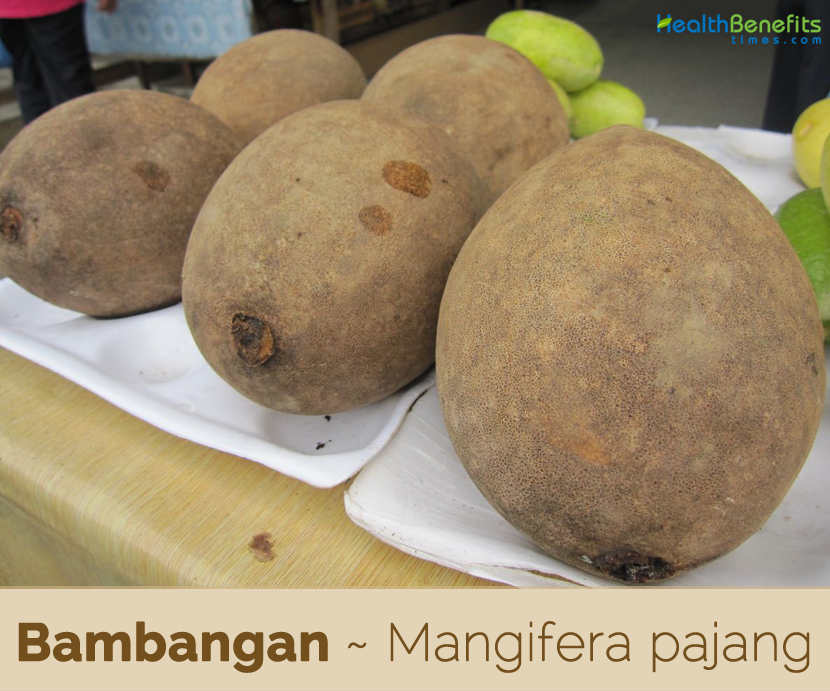| Bambangan Quick Facts | |
|---|---|
| Name: | Bambangan |
| Scientific Name: | Mangifera pajang |
| Origin | Borneo – Sarawak, Sabah, Brunei, Kalimantan |
| Colors | Potato Brown |
| Shapes | Drupe, brownish, globose to broad-ovoid, 15–20 cm across, roughish fruit |
| Flesh colors | Bright deep yellowish flesh |
| Taste | Taste sweet if the fruits falls to the ground but taste sour when it is unripe |
Plant Description
Bambangan is a tall, perennial, deciduous medium sized tree, 15–50 m high with huge, inaccessible columnar straight trunk with branches raised high above the ground and a bole of 30–70 cm with grey or sometimes dark brown, smooth or broadly fissured bark and an umbrella-shaped canopy high up the tree. The plant is found growing wild in the forests where the tropical agro climatic regime is humid and shaded. For instance in the lowland dipterocarp forest and in forest on well-drained alluvial soils. Areas with heavy rainfall and strong wind are not suited as conditions are detrimental to flower induction and fruit set. It can withstand prolong dry weather and flooding and can be grown on a wide range of soils including upland soils. It thrives best on, well-drained alluvial clay to sandy loam with pH ranging from 5 to 7. It cannot tolerate acid peat swamps or the leached coastal sandy beaches.
Leaves
Mature leaves are rigidly coriaceous, elliptic oblong or occasionally obovate-oblong, 17.5– 45 cm long by 7–15 cm wide, cuneate to attenuated base, acute to mucronate apex, entire margin, with 14–30 pairs of prominent nerves, usually dark green in color and borne on petioles up to 12 cm long. Young flushes are bronze to pink in color. Panicles are terminal and also in upper leaf axils, pyramidal, to 30 cm long with lateral branches up to 1 cm long and densely flowered.
Flower & Fruit
Inflorescence is a terminal and sub terminal panicle, erect, pyramidal, up to 30 cm long, densely flowered, glabrous, fragrant. Flowers are 5-merous, petals up to 9 mm long, outside pinkish-white, inside purple, becoming yellowish after anthesis, with 3 ridges confluent at base, disk stipe-like, one or two stamens fertile, staminodes smaller and unequal, filaments connate at base; ovary white. Fruit is drupe, brownish, globose to broad-ovoid, 15–20 cm across, roughish fruit that have thick rind about 5–10 mm thick and is peeled like a banana. Inside the thick skin is a bright deep yellowish flesh that is fibrous, sweet-acid, pleasantly aromatic. The fruit weight about 2-3 kg. The fruit consists of single stone plump that is 9 cm × 6.5 cm × 4.5 cm, endocarp is woody, up to 5 mm thick, and seed is mono embryonic.
History
The plant is native to Borneo – Sarawak, Sabah, Brunei, and Kalimantan. The species is found mostly wild in the forests or in scattered backyard plantings in villages. Areas of wild distribution are found mostly around Kapit, Ulu Dapoi, Long Silat in Sarawak; Sipitang, Sandakan, Beaufort in Sabah; Sangkulirang and west Kutei in Kalimantan. Nowadays it can be found in several parts of the world due to its amazing features.
Culinary uses of Bambangan
- Thick, acid sweet and mildly banana flavored, fibrous pulp is eaten fresh.
- The thick skin is edible when pickled or eaten fresh with sambal belacan.
- One food item that is widely consumed in the Kadazan-dusun community in Sabah is the ‘nonsom Bambangan’ or ‘jeruk Bambangan’.
- In Sarawak, the acid fruits are eaten with sambal belacan or cooked in a curry.
- Fresh young leaf flushes are sold in local markets and are cooked and consumed with sambal belacan or tempoyak.
- The peel, which possesses an aromatic smell, is sometimes used in cooking of local dishes.
- Thick skin is added in curry to give mangoish aroma, and can also be eaten after being pickled.
- Kernel or the seed is sometimes used with the flesh for making pickle.
Lists of delicacies of Bambangan Fruit
- Pickle Bambangan Fruit
- Fish Soup with cut Bambangan
- Stir-fry Salted Fish, pickle Bambangan and Chili.
Bambangan Pickles
Ingredients:
- 2-3 unripe Bambangan ( peeled & sliced the pulps into cubes )
- Cut split the seed.
- Grate the inner seed.
- Bird’s eye chilies to taste
- Salt to taste
Method
- Mix all the above ingredients together.
- Put them into a clean container & cover it tightly.
- Keep the container at room temperature for 1 week.
- Pickled Bambangan goes really well with plain white rice & deep-fried fish.
Pickled fish with bambangan fruit
Ingredients
- 500 g mackerel (ikan tenggiri)
- 60 g lime juice
- 30 g bambangan fruit (local fruit), diced
- 10 g red chili, chopped
- 4 g green bird’s eye chili, sliced
- 10 g ginger, minced
- 10 g shallot, sliced
- 3 g pickled papaya, sliced
- 3 g salt
- 2 g sugar
- 2 tbsp palm oil
Methods
- Prepare mackerel by washing it well, removing the bone and skin with a sharp knife, and then cutting it into small pieces.
- Transfer the fish into a bowl and add the lime juice, bambangan fruit, chilies, ginger shallot, pickled papaya, salt, sugar and palm oil, mixing all together. Let it stand for 5 minutes and serve.
References:
https://npgsweb.ars-grin.gov/gringlobal/taxonomydetail.aspx?id=316159
http://tropical.theferns.info/viewtropical.php?id=Mangifera+pajang
https://en.wikipedia.org/wiki/Mangifera_pajang
http://www.catalogueoflife.org/col/details/species/id/86f4ece12f12c9931adb86e3c5881d0f
http://www.academicjournals.org/journal/JMPR/article-full-text-pdf/1F683BD41963
https://uses.plantnet-project.org/en/Mangifera_pajang_(PROSEA)
Comments
comments
